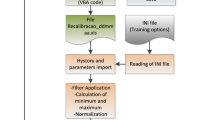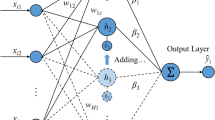Abstract
Application of accurate gas sampler and analyzers is the most reliable method for measuring cement kiln stack gas composition; however, both are very prone to frequent maintenance due to the presence of very fine dust particles in kiln stack gas. Reliable soft sensors are necessary for online concentration estimation of required components during down time of sampler or analyzer. Since accurate first principal models for cement kiln are very complex and time consuming to solve, artificial neural networks and support vector regression are applied as modeling tools. These tools are used to develop four soft sensors for prediction of O2, CO, NO and CH4 in kiln stack gas. A data set consisting of 29,600 data points on 25 process variables collected during a period of 7 month is used for soft sensor development. To have a meaningful comparison on performance, the same methods for plant data processing, feature variable selection and model optimization are applied for both artificial neural networks- and support vector regression-based soft sensors. Refined data set after data processing is divided into training, test and validation groups that contain 70%, 10% and 20% of data set, respectively. Both average absolute error and average absolute relative error calculated for soft sensor predictions revealed that support vector regression-based soft sensors are more accurate compared to corresponding artificial neural networks-based soft sensors.


Similar content being viewed by others
Abbreviations
- AAE:
-
Average absolute error
- AARE:
-
Average absolute relative error
- AE:
-
Absolute error
- ANN:
-
Artificial neural networks
- DG:
-
Dividing gate
- EP:
-
Electrostatic precipitator
- GA:
-
Genetic algorithm
- HAD:
-
Hoisting air damper
- ID:
-
Induced draft
- KB:
-
Kiln burner
- MAD:
-
Median absolute deviation
- PCA:
-
Principal component analysis
- RBF:
-
Radial basis function
- SVR:
-
Support vector regression
- b :
-
Bias value
- b j :
-
Bias
- C :
-
Regularizing parameter
- F :
-
Function
- f j :
-
Activation function
- J :
-
Objective function
- \(K\left( {x_{i} ,x_{j} } \right)\) :
-
Kernel function
- n :
-
Number of data point
- R :
-
Reference
- s j :
-
Weighted sum
- X :
-
Data matrix
- \(x_{i}\) :
-
Feature vector
- \(\tilde{x}_{{{\text{Exp}}.}}\) :
-
Normalized value
- \(x_{\hbox{min} }\) :
-
Minimum value
- \(x_{\hbox{max} }\) :
-
Maximum value
- \(x_{{{\text{Exp}}.}}\) :
-
Experimental data
- \(\bar{x}\) :
-
Mean
- Y :
-
Future outputs
- YΣ:
-
Transformed data matrix
- y i :
-
Target value
- σ:
-
Standard deviation
- φ:
-
Transformation of feature vector
- \(\xi_{i}^{{}}\) :
-
Slack variable
- \(\xi_{i}^{ *}\) :
-
Slack variable
- \(\alpha_{i}^{{}}\) :
-
Lagrange multipliers
- \(\alpha_{i}^{ *}\) :
-
Lagrange multipliers
References
Adib H, Sharifi F, Mehranbod N et al (2013) Support vector machine based modeling of an industrial natural gas sweetening plant. J Nat Gas Sci Eng 14:121–131. https://doi.org/10.1016/j.jngse.2013.06.004
Azzam M, Awad M, Zeaiter J (2018) Application of evolutionary neural networks and support vector machines to model NOx emissions from gas turbines. J Environ Chem Eng 6:1044–1052. https://doi.org/10.1016/j.jece.2018.01.020
Brank J, Grobelnik M, Milić-Frayling N, Mladenić D (2002) Feature selection using linear support vector machines. In: Management information systems. pp 261–273
Burns RS (2001) Advanced control engineering. Elsevier. https://doi.org/10.1016/B978-0-7506-5100-4.X5000-1
Casali A, Gonzalez G, Tones F et al (1998) Particle size distribution soft-sensor for a grinding circuit. Powder Technol 99:15–21
Chang C, Lin C (2013) LIBSVM : a library for support vector machines. ACM Trans Intell Syst Technol 2:1–39. https://doi.org/10.1145/1961189.1961199
Cuadra L, Alexandre E, Alvarez L, Rosa-Zurera M (2008) Reducing the computational cost for sound classification in hearing aids by selecting features via genetic algorithms with restricted search. In: ICALIP 2008—2008 international conference on audio, language and image processing, proceedings. pp 1320–1327
Datta S, Dev VA, Eden MR (2017) Hybrid genetic algorithm-decision tree approach for rate constant prediction using structures of reactants and solvent for Diels–Alder reaction. Comput Chem Eng. https://doi.org/10.1016/j.compchemeng.2017.02.022
Fortuna L, Graziani S, Rizzo A, Xibilia MG (2006) Soft sensors for monitoring and control of industrial processes. Springer, Berlin
Jang WH, Hahn J, Hall KR (2005) Genetic/quadratic search algorithm for plant economic optimizations using a process simulator. Comput Chem Eng 30:285–294. https://doi.org/10.1016/j.compchemeng.2005.09.007
Kadlec P, Gabrys B, Strandt S (2009) Data-driven soft sensors in the process industry. Comput Chem Eng 33:795–814
Kosmatka S (2003) Kirk-Othmer encyclopedia of chemical technology. Wiley, Hoboken
Li Z (2010) Support vector machine model based predictive PID control system for cement rotary kiln. Chin Control Decis Conf 2010:3117–3121. https://doi.org/10.1109/CCDC.2010.5498646
Marengo E, Bobba M, Robotti E (2006) Modeling of the polluting emissions from a cement production plant by partial least-squares, principal component regression, and artificial neural networks. Environ Sci Technol 40:272–280
Miao Y, Su H, Wang W, Chu J (2011) Simultaneous data reconciliation and joint bias and leak estimation based on support vector regression. Comput Chem Eng 35:2141–2151. https://doi.org/10.1016/j.compchemeng.2011.06.002
Pani AK, Vadlamudi VK, Mohanta HK (2013) Development and comparison of neural network based soft sensors for online estimation of cement clinker quality. ISA Trans 52:19–29. https://doi.org/10.1016/j.isatra.2012.07.004
Porrazzo R, Cipollina A, Galluzzo M, Micale G (2013) A neural network-based optimizing control system for a seawater-desalination solar-powered membrane distillation unit. Comput Chem Eng 54:79–96. https://doi.org/10.1016/j.compchemeng.2013.03.015
Ribeiro B (1987) Prediction of the lime availability on an industrial kiln by neural networks. In: 1998 IEEE international joint conference on neural networks proceedings. IEEE world congress on computational intelligence (Cat. No.98CH36227). pp 1987–1991
Vapnik VN (2000) The nature of statistical learning theory
Zhang S, Wang F, He D, Jia R (2012) Real-time product quality control for batch processes based on stacked least-squares support vector regression models. Comput Chem Eng 36:217–226. https://doi.org/10.1016/j.compchemeng.2011.05.015
Zhang D, Xiao J, Zhou N et al (2015) A genetic algorithm based support vector machine model for blood-brain barrier penetration prediction. Biomed Res Int 2015:292683
Acknowledgements
Financial support from the Vice Chancellor for Research Affairs of Shiraz University is gratefully acknowledged.
Author information
Authors and Affiliations
Corresponding author
Additional information
Editorial responsibility: J Aravind.
Rights and permissions
About this article
Cite this article
Khosrozade, A., Mehranbod, N. Comparison of support vector regression- and neural network-based soft sensors for cement plant exhaust gas composition. Int. J. Environ. Sci. Technol. 17, 2865–2874 (2020). https://doi.org/10.1007/s13762-019-02564-4
Received:
Revised:
Accepted:
Published:
Issue Date:
DOI: https://doi.org/10.1007/s13762-019-02564-4




